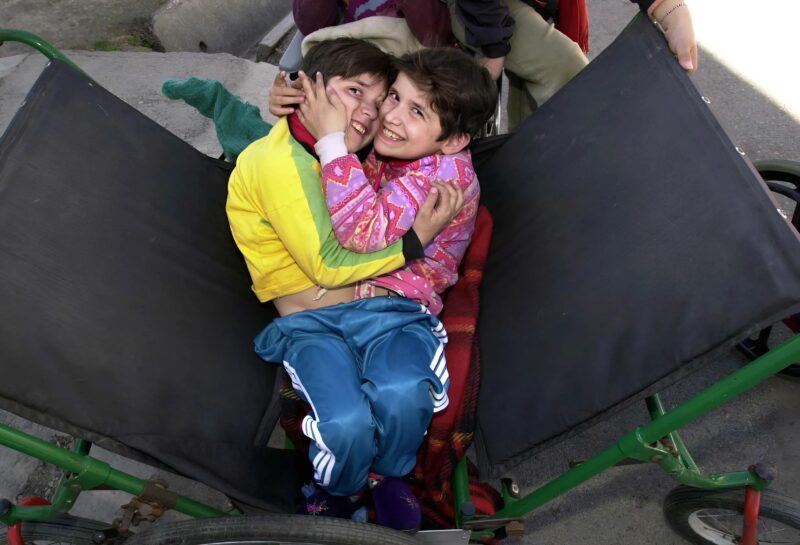
Zita and Gita’s story begins in a way few could ever fully imagine. Born as conjoined twins, their lives were intertwined from the very first moment—fused at the pelvic area in a way that defied most medical explanations. They shared a complex web of organs, including their intestine and reproductive system, and their joined bodies resulted in three legs—an unusual and astonishing configuration. Despite the physical connection, each girl had her own head, her own heart, and her own arms, a testament to the incredible way their bodies developed together.
From a very young age, Zita and Gita learned to live in perfect harmony, both physically and emotionally. Their bond was a constant, unbreakable thread that held their lives together through every challenge and joy. They did everything side by side—learning to eat, to speak, to walk, and to navigate the world around them. Their childhood was filled with a child’s innocence and wonder; they accepted their uniqueness with a natural, childlike understanding. They drew pictures of people with three legs, often tying two dolls together and pulling off one so that the dolls would “match” them—like a playful mirror of their own bodies. This simple act of their childhood was a reflection of their innocence and the way they saw themselves without shame or fear.
But as they grew older, their perspective shifted. Their innocence gradually gave way to a longing—to be separate, to have their own individual lives and identities. The dream of independence became their shared goal, one they nurtured despite the doubts and fears from the outside world. They wanted to walk freely, to be autonomous, to be just like everyone else. Their bond, which had been a symbol of strength and unity during childhood, now felt like a barrier—something they yearned to free themselves from.
When they turned 11, the challenge to their dreams intensified. Doctors faced one of the most difficult surgeries in recent history—an operation that had been tried in only a few cases worldwide, with limited success. The risks were immense; almost always, either one twin was lost or the surgery failed altogether. Yet, the medical team was determined to try, driven by the hope of giving these girls a chance at separate lives. The operation was a monumental undertaking: 12 hours of meticulous, delicate work to separate their bodies and remove the “extra” leg that held them together.
The surgery was a success—an unbelievable victory in the face of impossible odds. The twins survived, and even though the process was fraught with danger and complexity, the medical team managed to free them from their shared form. For the first time in their lives, Zita and Gita could stand empty-handed on their own two feet, and they learned to walk once again—this time, with the help of prosthetic legs. The transition was not easy; it took time, patience, and a lot of physical and emotional adjustment. But the girls gritted their teeth and pushed through every setback.
They graduated from school, eager to live as independently as possible. They picked up new skills—learning foreign languages, discovering a love for drawing and crafting, and finding joy in the small things that life now offered them. Their complex anatomy still made itself felt, and they required constant medical supervision. The scars of their journey, both physical and emotional, stayed with them, but their spirits remained unbroken.
However, happiness was fleeting. Just after the success of their separation, tragedy struck. Zita developed sepsis—a severe, life-threatening infection brought on by complications from the surgery. Despite emergency treatment, her condition worsened, and she passed away. Her death left Gita devastated—her sister was her partner, her best friend, and her whole world. The loss was unimaginable, an almost unbearable pain.
In the years that followed, Gita was left to carry not only her own struggles but also the memory of her sister. She continued to live, fighting for her health and hope. Then, a new challenge arose: she was diagnosed with cancer. At 33, Gita faced another battle—surgery on her intestines, multiple rounds of aggressive treatment, and a constant fight for her life. But through it all, her determination never waned. She refused to give up, holding onto the memory of her sister and the hope of a better future.
Her story is one of resilience—an extraordinary testament to the strength of the human spirit. Gita continues to fight, step after step, day after day. She lives with hope, carrying her sister’s spirit in her heart as she ventures forward, fully aware of the fragile, precious nature of life. Her journey reminds us all that even in the face of the greatest hardship, love and perseverance can carry us through the darkest times. And though her path has been marked by loss and pain, her resilience is a shining example of the incredible power of hope and the unbreakable bonds that define us.







